![]()
![]()
![]()
Use LEFT and RIGHT arrow keys to navigate between flashcards;
Use UP and DOWN arrow keys to flip the card;
H to show hint;
A reads text to speech;
38 Cards in this Set
- Front
- Back
- 3rd side (hint)
|
What do you call a red blood cell in a hypertonic solution? |
Plasmolyzed |
|
|
|
What do you call it when a red blood cell bursts in a hypotonic solution? |
Hemolysis |
|
|

To make
|
1. Plasma membrane 2. Chloroplasts (in cytoplasm) 3. Cell wall 4. Space between (cell wall and plasma membrane) This cell is in a hypertonic solution. It is plasmolyzed. |
The labels are: cell wall, chloroplasts in cytoplasm, plasma membrane, space between cell wall and plasma membrane. |
|
|
What are the three bacterial shapes? |
Coccus, bacillus, and spirillum |
CBS |
|
|
What does a gram stain detect? |
The gram-positive bacteria have a thicker peptidoglycan cell wall. |
|
|
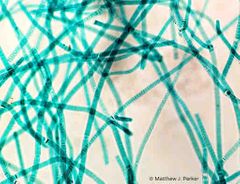
What kind of organism is this, and what is it? What, if present, does the nucleus look like? |
Bacteria, mixed blue-green algae. It has no nucleus. |
|
|

What kind of an organism is this, and what is it? What, if present, does the nucleus look like? |
Protist, Stentor. It looks like a string of beads. |
|
|

What kind of an organism is this, and what is it? What, if present, does the nucleus look like? |
Bacteria, Anabaena. No nucleus. |
|
|
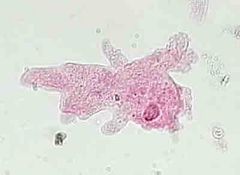
What kind of an organism is this, and what is it? What, if present, does the nucleus look like? What are some other important structures (2)? |
Protist, Amoeba proteus. The nucleus is a dark spot. The pseudopodia and food vacuole. |
One is for motility, the other is something to do with food... |
|
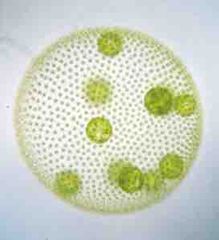
What kind of an organism is this, and what is it? |
Protist, Volvox |
|
|

What kind of an organism is this, and what is it? What, if present, does the nucleus look like? |
Protist, Trypanosoma gambiense. Those dark spots in the middle (hard to see on this photo). |
|
|

What kind of an organism is this, and what is it? What, if present, does the nucleus look like? |
Protist, spirogyra. You can’t see it on this photo, it’s in the middle of the green stuff |
|
|

What kind of an organism is this, and what is it? What, if present, does the nucleus look like? One more defining feature? |
Protist, Paramecium. A dark circle. Oral groove/gullet. |
g |
|
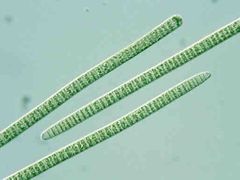
What kind of an organism is this, and what is it? What, if present, does the nucleus look like? |
Bacteria, Oscillatoria. No nucleus. |
|
|

What kind of an organism is this, and what is it? What, if present, does the nucleus look like? |
Protist, Euglena. A blank-ish spot(?). |
|
|

What type of organism is this, and what is it? What, if present, does the nucleus look like? |
Protist, Chlamydomonas. The nucleus is in the middle. |
|
|

What kind of an organism is this, and what is it? What, if present, does the nucleus look like? |
Protist, Diatoms. Organelle in center. |
|
|

Label these. Also, what organism is this? |

Spirogyra. |
Labels: conjugation tube, zygote. |
|

Study this picture. What organism is this? |
Anabaena. |
|
|
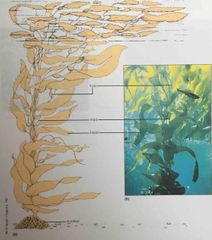
Study this photo. What organism is this? |
Macrocystis |
|
|

Study this photo. What organisms is this? |
They are both dinoflagellates. |
|
|

Study this photo. What organism is this? |
Trypanosoma |
|
|

Study this photo. What organism is this? |
Paramecium. |
|
|
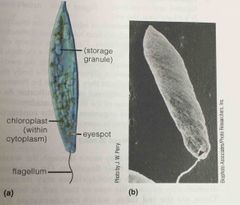
Study this photo. What organism is this? |
Euglena |
|
|

Study this photo. What organism is this? |
Trichinympha |
|
|
|
What is the Plasmodium vivax life cycle? (Malaria) (The answer is specific, but I’m only asking for general) |

1. In the gut of a female mosquito carrying the malaria parasite the zygotes of the parasite develop into sporozoits, which migrate to her salivary gland.
2. Mosquito bites a human, sporozoites enter bloodstream and reach liver. 3. Sporozoites reproduce in liver cells. 4. Progeny enter bloodstream |
|
|

Study this photo. What organism is this? Labels: ectoplasm, endoplasm, nucleus, contractile vacuole, food vacuole. |
Amoeba |
|
|

Study this photo. What organism is this? |
Chara |
|
|

Study this photo. What organism is this? |
Chara |
|
|
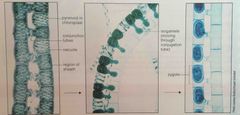
This is Spirogyra. What process is this? |
Sexual reproduction. |
|
|

Study this photo. What organism is this? |
Chlamydomonas |
|
|

Study this photo. What organism is this? |
Volvox |
|
|

Study this photo. What organism is this? |
Oedogonium |
|
|
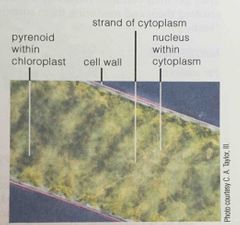
Study this photo. What organism is this? |
Spirogyra |
|
|
|
What do we use to test for glucose? |
Benedict’s solution |
|
|
|
What do we use to test for starch? |
Iodine- potassium iodide |
|
|
|
What do we use to test for lipids? |
Sudan IV fat stain |
|
|
|
Do you remember all this? Are you ready for the quiz? |
Yes, I do! I’m ready! |
Be honest 🙏🏻 |

